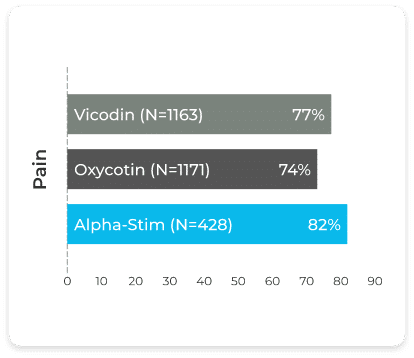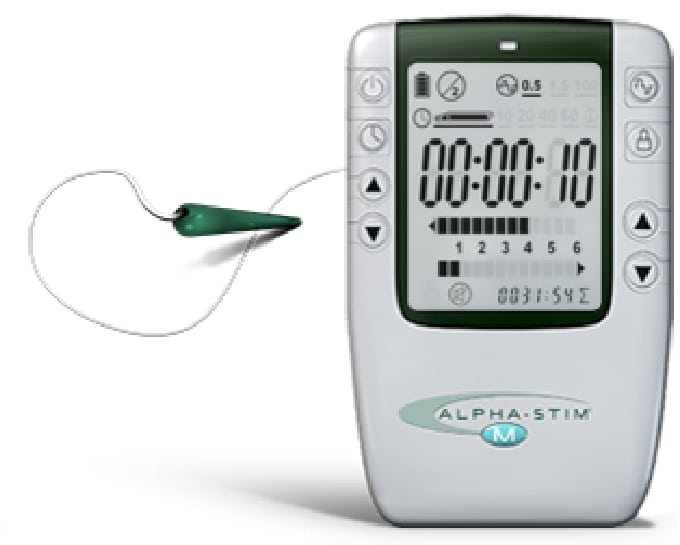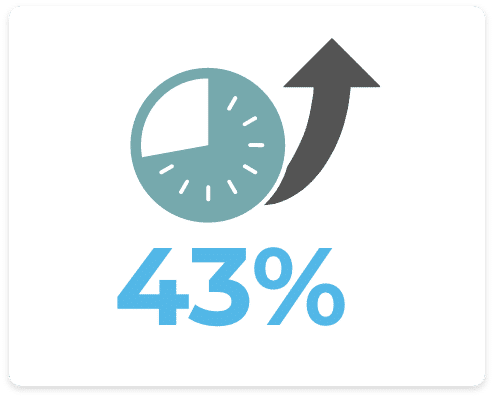
with Alpha-Stim M
medical device for acute, chronic and post-traumatic pain
relief, along with being able to treat the anxiety, insomnia,
and depression* that can sometimes accompany pain.
Alpha-Stim M
Take Charge
of your life


Alpha-Stim M Features
- Treats acute and chronic pain conditions throughout the body
- Treats post-traumatic pain
- Can be used as a first-line therapy for pain management, anxiety, insomnia, and depression
- Can be used as an adjunct to pharmacotherapy without polypharmacy effects
- Can be used at home by patients safely and easily
- Includes handheld probes or self-adhesive electrodes for MET pain therapy
- Includes earclips for CES therapy for treating anxiety, insomnia, and depression, which are common comorbidities associated with pain
Proven to provide pain relief

Severe Pain Reduction

Decrease in Post-Traumatic Pain
In a post-traumatic pain study, 56% of patients at 3 months and 85% at 6 months were somewhat or very satisfied with the device for reducing pain levels. 2

Improved
Function

Better than
drug-treatments
Two Separate Modalities
The Alpha-Stim M includes handheld Smart Probes or AS-Trode self-adhesive electrodes for site-specific MET pain therapy, as well as earclips that provide cranial electrotherapy stimulation (CES)—to relieve common comorbidities associated with pain, including anxiety, insomnia, and depression.



Overall Decrease in Anxiety

Increased Sleep Time

Decrease in Depression
Take charge of Your life
Alpha-Stim M is an FDA cleared non-drug, non-surgical device designed to relieve acute, chronic, and post-traumatic pain, along with anxiety, insomnia, and depression.
Alpha-Stim vs. TENS Therapy for Pain Relief
Both Alpha-Stim and transcutaneous electrical nerve stimulation (TENS) units are used to provide drug-free pain treatment, but there is a big difference in what they do and how they perform.
And while they both provide pain relief via an electrical device, that’s where the similarities end.
Many choose a TENS unit at first because it can be quick to initially reduce some pain; however, the results are usually short-term. Conversely, the effects of Alpha-Stim are not only fast-acting but long-lasting and cumulative, for more sustainable pain relief over time.
Learn more about the differences between Alpha-Stim and TENS here >
Both Alpha-Stim and transcutaneous electrical nerve stimulation (TENS) units are used to provide drug-free pain treatment, but there is a big difference in what they do and how they perform.
And while they both provide pain relief via an electrical device, that’s where the similarities end.
Many choose a TENS unit at first because it can be quick to initially reduce some pain; however, the results are usually short-term. Conversely, the effects of Alpha-Stim are not only fast-acting but long-lasting and cumulative, for more sustainable pain relief over time.
Learn more about the differences between Alpha-Stim and TENS here >



A Technology Patients & Providers Trust
Alpha-Stim has been helping hundreds of thousands of people take charge of their anxiety, insomnia and pain. Alpha-Stim technology has led the way with innovative non-drug medical devices. Alpha-Stim AID and Alpha-Stim M devices are highly praised by both patients and providers.
Alpha-Stim Mobile App & Accessories
To help you get the most out of your Alpha-Stim M, explore our Alpha-Stim accessories. Our unique mobile app also offers Alpha-Stim users a personalized way to keep track of sessions and progress over time.

Everything you need to keep up with your Alpha-Stim M treatments. Explore our collection of Alpha-Stim M accessories including a carrying case, earclip electrodes, AS-Trodes™, and more.

Keep track of your progress with Alpha-Stim AID or Alpha-Stim M with the Alpha-Stim Health Tracker App. Track your treatment sessions, log daily check-ins, view progress analytics, take assessments and more.
TAKE CHARGE OF YOUR LIFE WITH ALPH-STIM

telehealth
Visit
Sources:
1 Holubec, Jerry T. Cumulative response from cranial electrotherapy stimulation (CES) for chronic pain. Practical Pain Management. 2009; 9(9):80-83..
2 Tan, Gabriel, Rintala, Diana, Jensen, Mark P., Richards, J. Scott, Holmes, Sally Ann, Parachuri, Rama, Lashgari-Saegh, Shamsi and Price, Larry R. Efficacy of cranial electrotherapy stimulation for neuropathic pain following spinal cord injury: a multi-site randomized controlled trial with a secondary 6-month open-label phase. The Journal of Spinal Cord Medicine. 2011; 34(3):285-296.
3 Taylor AG, Anderson JG, Riedel SL, et al. Cranial Electrotherapy Stimulation improves symptoms and functional status in individuals with fibromyalgia. Pain Management Nursing. 2013 Dec; 14(4):327-335.
4 Kirsch, D.L., Price, L.R., Nichols, F., Marksberry, J.A., & Platoni, K.T. Military Service Member and Veteran Self-Reports of Efficacy of Cranial Electrotherapy Stimulation for Anxiety, PTSD, Insomnia, and Depression. (2014). The Army Medical Department Journal, 46-54.
- 5 Barclay TH, Barclay RD. A clinical Trial of cranial electrotherapy stimulation for anxiety and comorbid depression. Journal of Affective Disorders. 2014;164:171-177. Presented at the American Psychological Association National Conference, Honolulu, July 2013.
- 6 Lande RG, Gragnani C. Efficacy of Cranial Electric Stimulation for the treatment of insomnia: A randomized pilot study. Complementary Therapies in Medicine. 2013; 21(1):8-13.
- 7 Barclay TH, Barclay RD. A clinical Trial of cranial electrotherapy stimulation for anxiety and comorbid depression. Journal of Affective Disorders. 2014; 164:171-177. Presented at the American Psychological Association National Conference, Honolulu, July 2013.





